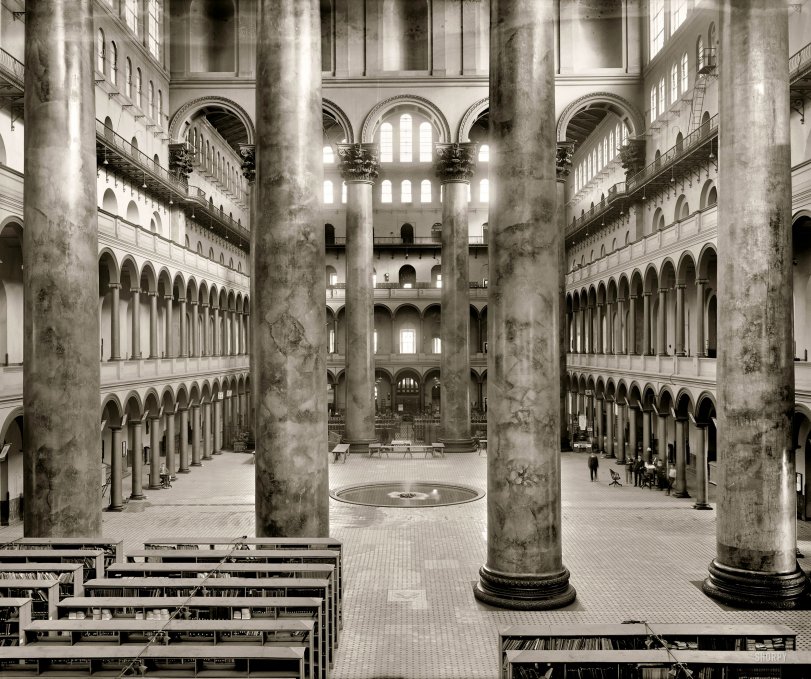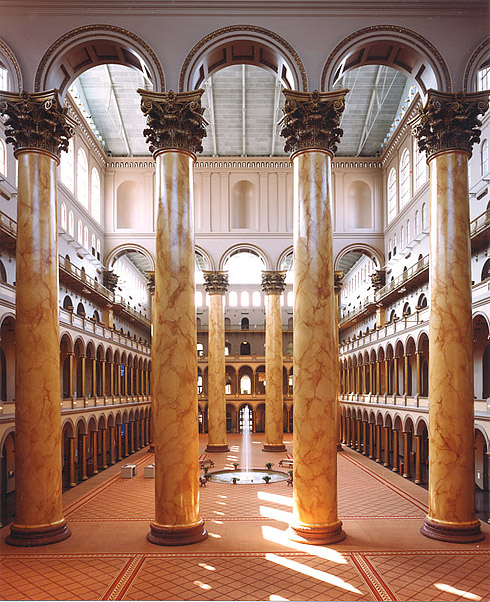


Framed or unframed, desk size to sofa size, printed by us in Arizona and Alabama since 2007. Explore now.
Shorpy is funded by you. Patreon contributors get an ad-free experience.
Learn more.

- Details, Details
- What's that building to the left of the tower?
- Coal Barges
- Bromo-Seltzer
- Inner harbor
- The Basin
- What a headache!
- Giant stepladder?
- Baldwin 62303
- Baldwin VO-1000
- Cold
- No expense spared
- Tough Guys
- Lost in Toyland
- And without gloves
- If I were a blindfolded time traveler
- Smoke Consumer Also Cooks
- Oh that stove!
- Possibly still there?
- What?!?
- $100 Reward
- Freeze Frame
- Texas Flyer wanted
- Just a Year Too Soon
- WWII -- Replacing men with women at the railroad crossing.
- Yes, Icing
- You kids drive me nuts!
- NOT An Easy Job
- I wonder
- Just add window boxes
Print Emporium
Pension Office: 1918

Washington, D.C., circa 1918. "Pension Office interior." This former repository of Civil War veterans' pension records is now the National Building Museum. National Photo Company Collection glass negative. View full size.
NBM
I visited this building on my vacation this summer, and absolutely you do feel small upon entering it. The staircases with low risers are interesting also.
Not only is the building a pleasure to look at, but it has quite a few very interesting exhibits about Washington (all free, though they recommend a donation of $5), and an amazing gift shop with books on design and architecture. Many of the exhibits show photos similar to the ones on this site.
One of the newer exhibits on green building explains that when the building was new it had awnings on the windows as another temperature control feature. The windows are also placed to get sun in different ways in different seasons.
I had never heard of this building or the National Building Museum until I happened upon it while wandering around and stepped in. I'm very glad I did.
National Building Museum
I live in the DC area, and have visited this building a number of times. I consider it a very fine example of architecture, and an interesting place to visit. I find it astonishing that some people consider this beautiful 125-year-old building to be a waste of money. Geez, if this building is bad, I'll bet the national monuments, art galleries and other museums in Washington would REALLY be considered "frivolous."
50-50
It's fascinating that the comments seem to be pretty evenly split: about half complaining of the waste and ugliness of the building; and about half seeing the beauty of the building and stating that the citizens certainly got their money's worth. I've never been to the building personally, but it's awe inspiring to me. Next time I'm in D.C., I'll most certainly track it down.
A bargain
I'm very much offended by government waste, but this building is not anything like that. If it cost $886,000 to build back then, that's only about $18-$19 million in today's dollars. To put that in perspective, the recently opened new Birmingham, Alabama, office for the Social Security Administration cost $135 million, and in my opinion it's not remotely attractive.
Eeeww!
Are those spittoons on the floor by the colonnades? Every time I look, there's another one!
Hi-Tech Ventilation
One of my favorite buildings in D.C. ...
The Anonymous Tipster is correct in noting the good ventilation achieved in the building. Montgomery Meigs paid special attention to issues of ventilation in his design: in addition to the clerestory windows at the top, the masonry was constructed with special passages for air flow. When in use, a special team was employed to run around the building, opening and closing windows during the day to adjust the air flow. Meigs estimated that the air in the Great Hall could be exchanged every two minutes.
Exit question for iamfelix
Exit question for iamfelix ("Lovely"). This would have consumed the entire tax receipts of how many US citizens in 1918?
[This building was 30 years old when the photo was taken. It cost $886,000. Construction commenced in 1882 and lasted five years. It was commissioned by Congress in 1881 as headquarters for the Pension Bureau, a huge department responsible for handling benefits for the country's thousands of Civil War veterans as they began to enter retirement age. Congress stipulated that the building be both inexpensive and fireproof. Considering that it's lasted for well over 100 years, I'd say the taxpayers got their money's worth. - Dave]
They're Brick Columns
Those beautiful columns, in this, one of the best buildings I've ever seen, are laid-up bricks. Then plastered and painted to look like what the budget could not afford: marble. And the building was used for an inauguration ball not very long ago.
Lovely
I don't find it depressing or a waste. I think it's beautiful. Why should public spaces be ugly and soulless, whatever their function? There's more than enough ugly.
From a different era
Imagine the outcry that would ensue today, if the Federal or State government erected a bureaucratic building with such costly grandeur? A backlash would result, and legions of people would assail it as frivolous, costly, and inefficient government expenditure.
In the 1920s they could have gotten away with something like this. But that was certainly a different era, a different time.
[This building was constructed in the 1880s. Completed in 1887. - Dave]
Atrium Ventilation
Depressing waste? No. As has been pointed out, it was built long before air conditioning, and the central court was designed to ventilate air to the roof, as well as the high ceilings on each floor. It housed 1500 workers when the pension department was expanded in a short time. And the court was also intended for ceremonial occasions as well -- several presidential inaugural balls were held here.
Interestingly also, the designers made sure to include a freed slaves in the frieze running along the outside.
At one time in the early 1960s,
this grand old space was used as overflow office space for employees of the Civil Service Commission (now the Office of Personnel Management). The building had not been maintained very well, and apparently had many unsealed openings to the outside.
A friend who worked there put up with temperature extremes and vermin. The only pleasant distraction was watching the antics of the birds which flew freely around the great atrium space.
Remarkable Design
I think the design of the building is remarkable. The offices where the hundreds of clerks toiled are around the periphery. It was built LONG before air conditioning. The taller central area must provide a sort of flue where the hot air rises bring in fresh air to the offices. Montgomery Meigs did a pretty good design.
Still there and lovelier than ever
As the National Building Museum, this great central space is the first thing you see as you walk in the door. The columns are there, exactly as shown (they are hollow, painted to look like marble), the central fountains and loft ceiling make this one of the pleasantest public spaces in the nation's capital.
Restored!
The National Building Museum has restored the space. It looks much like it did when the photo was taken. The Files are now gone and the tile floor is now carpeted except for a cut-out exposing the shield between the columns. The fountain spray is configured differently now, too. It is now a tall column of water rather than a multiple sprays.
This is one of the most impressive interior spaces in Washington and is well worth a visit to see. The view of the exterior of the building as you come up from Judiciary Square Metro Station is incredible, too. It is probably the most dramatic view from any Metro escalator.

Temple of the Bureaucrat
A temple of the bureaucrat, with marble pillars and tile floors along with at least three barriers to get to the business end of the building. And no one fixed the fountain as it overflows on the tile.
Depressing Waste
I don't know which is more depressing -- the sheer vulgarity of this massive government temple or the tragic war records it housed.
Superb!
By anyone's definition, a truly Grand Space! Extraordinary!
Faces
Thank you for this photo. My father has loved this building all his life and often mentioned the faux-marble columns, saying that people claimed they could see the faces of the dead soldiers looking at them from the marbled paint, then shifting back to marble again. It was hard, as a child, for me to picture this; by the 1970s, these columns were painted beige. I can see what he meant now.
Wow
The corinthian columns are both massive and gorgeous. I wonder how they compare size wise to the ones holding the roof up on the Hagia Sophia.
Land of the giants
Very imposing building, I'll bet you that would feel very small when you entered.
Can you imagine
Can you imagine the government building anything even remotely like this spectacular structure today for the purpose of storing pension records? The contemporary version of this would be a windowless, poured concrete atrocity full of cubicles, computer terminals, and fluorescent light bulbs, i.e., hell on earth.
























On Shorpy:
Today’s Top 5